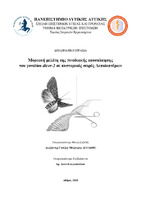| dc.contributor.advisor | Kolliopoulou, Anna | |
| dc.contributor.author | Μαζουρέκ, Αλεξάντερ Γιούζεφ | |
| dc.date.accessioned | 2021-03-15T11:42:20Z | |
| dc.date.available | 2021-03-15T11:42:20Z | |
| dc.date.issued | 2021-03-05 | |
| dc.identifier.uri | https://polynoe.lib.uniwa.gr/xmlui/handle/11400/404 | |
| dc.identifier.uri | http://dx.doi.org/10.26265/polynoe-255 | |
| dc.description.abstract | Επιβλαβή Λεπιδόπτερα προκαλούν μεγάλες γεωργικές και οικονομικές ζημιές παγκοσμίως, ενώ η καταπολέμησή τους με τα παραδοσιακά εντομοκτόνα δεν φέρει τα αναμενόμενα αποτελέσματα. Μία ενδιαφέρουσα εναλλακτική προσέγγιση είναι η πρόσληψη μέσω ιόμορφων σωματιδίων, ειδικά σχεδιασμένων δίκλωνων μορίων RNA (dsRNA) από τα έντομα για την αποσιώπηση γονιδίων μέσω RNA παρεμβολής (RNAi). Ωστόσο, είναι γνωστό ότι η λειτουργία του ενζύμου-κλειδιού του RNAi μηχανισμού, που κωδικοποιείται από το γονίδιο dicer-2 μετατρέπει τα dsRNA σε μικρά παρεμβαλλόμενα RNA (siRNA). Προκειμένου λοιπόν να καταστεί εφικτή η παραγωγή μεγάλων ποσοτήτων dsRNA διερευνήθηκε η χρήση μοριακών κατασκευών, οι οποίες αξιοποιούν τις τεχνικές RNAi και CRISPR/Cas9, για την αποσιώπηση του γονιδίου dicer-2 σε κύτταρα ωοθήκης των Λεπιδοπτέρων Spodoptera frugiperda (Sf21) και Trichoplusia ni (Hi5). Η στρατηγική εφαρμογής της τεχνικής RNAi αποσκοπεί στη μόνιμη αποσιώπηση του γονιδίου dicer-2 μέσω σταθερής έκφρασης μιας ειδικής RNA φουρκέτας σε μετασχηματισμένη κυτταρική
σειρά. Η παραγόμενη φουρκέτα θα κατακερματίζεται από τη δράση του ενζύμου Dicer-2 σε μικρά μόρια, τα οποία λόγω της συμπληρωματικότητάς τους θα υβριδίζουν με το mRNA του dicer-2 και θα το αποσιωπούν. Αντιθέτως, η στρατηγική εφαρμογής της τεχνικής CRISPR/Cas9 περιλαμβάνει την επιλογή ειδικών αλληλουχιών-στόχων, μέσω των οποίων θα στοχεύεται το γονίδιο dicer-2 από την ενδονουκλεάση SpCas9, προκαλώντας βλάβη σε αυτό μέσω απώλειας βάσεων και συνεπώς σημαντική μείωση της έκφρασής του. Τα δεδομένα που συλλέχθηκαν κατά την παρούσα μελέτη επιβεβαιώνουν την αποδοτικότητα των δύο τεχνικών και μπορούν να αξιοποιηθούν σε συνδυασμό με περαιτέρω διερεύνηση, για μελλοντικές μελέτες σχετικά με τον έλεγχο επιβλαβών
εντόμων. | el |
| dc.format.extent | 198 | el |
| dc.language.iso | el | el |
| dc.publisher | Πανεπιστήμιο Δυτικής Αττικής | el |
| dc.rights | Αναφορά Δημιουργού - Μη Εμπορική Χρήση - Παρόμοια Διανομή 4.0 Διεθνές | * |
| dc.rights | Attribution-NonCommercial-NoDerivatives 4.0 Διεθνές | * |
| dc.rights | Attribution-NonCommercial-NoDerivatives 4.0 Διεθνές | * |
| dc.rights.uri | http://creativecommons.org/licenses/by-nc-nd/4.0/ | * |
| dc.subject | Γονιδιακή αποσιώπηση | el |
| dc.subject | Λεπιδόπτερα | el |
| dc.subject | RNAi | el |
| dc.subject | CRISPR/Cas9 | el |
| dc.subject | Hi5 | el |
| dc.subject | Sf21 | el |
| dc.subject | Gene silencing | el |
| dc.subject | Lepidoptera | el |
| dc.subject | AcMNPV | el |
| dc.subject | Dicer-2 | el |
| dc.subject | SiRNA | el |
| dc.title | Μοριακή μελέτη της γονιδιακής αποσιώπησης του γονιδίου dicer-2 σε κυτταρικές σειρές Λεπιδοπτέρων | el |
| dc.title.alternative | Molecular study of dicer-2 gene silencing in Lepidopteran cell lines | el |
| dc.type | Πτυχιακή εργασία | el |
| dc.contributor.committee | Beloukas, Apostolos | |
| dc.contributor.committee | Kolliopoulou, Anna | |
| dc.contributor.committee | Βογιατζάκη, Χρυσάνθη | |
| dc.contributor.faculty | Σχολή Επιστημών Υγείας & Πρόνοιας | el |
| dc.contributor.department | Τμήμα Βιοϊατρικών Επιστημών | el |
| dc.description.abstracttranslated | Lepidopteran pests cause severe agricultural and economic damage worldwide, while their control by use of traditional insecticides does not lead to the expected results. An interesting alternative approach is gene silencing through RNA interference (RNAi), mediated by the uptake of specially designed double-stranded RNA (dsRNA) molecules, being encapsidated into viral-particles. However, the key RNAi mechanism enzyme, encoded by the dicer-2 gene, is known to function by converting dsRNAs into small interfering RNAs (siRNAs). Therefore, in order to enable the production of dsRNA in large quantities, the use of molecular constructs utilizing RNAi and CRISPR/Cas9 techniques was investigated to silence the dicer-2 gene in Spodoptera frugiperda (Sf21) and Trichoplusia ni (Hi5) ovary-derived cells. The application strategy of the RNAi technique aims at the permanent silencing of the dicer-2 gene through the stable expression of a specific hairpin RNA in a transformed cell line. The produced hairpin will be fragmented into small molecules due to the action of Dicer-2 enzyme, which will hybridize to the complementary mRNA of dicer-2 and silence it. In contrast, the implementation strategy of CRISPR/Cas9 technique involves the selection of specific target sequences, which will lead the SpCas9 endonuclease to target the dicer-2 gene, causing damage to it through loss of bases and thus significant downregulation in terms of gene expression. The data collected in the present study confirm the efficiency of both techniques and can be used in conjunction with further investigation for future studies on insect pest control. | el |


